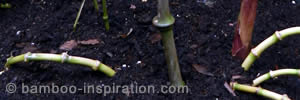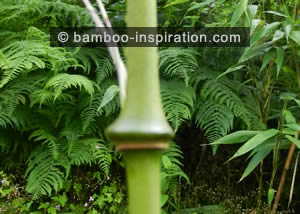- Home ›
- Bamboo Plants ›
- Chimonobambusa
Chimonobambusa Bamboo
The bamboo genus Chimonobambusa, known to be vigorous in spreading habit, needs either space to grow in a large garden, or to be contained.
Really it is best to allow bamboos to grow in a natural way and this is a genus that can be let to run wild if you have no worries about the amount of space a plant from this genus may eventually take up.
Most of the species originate from China, Southeast Asia, and Japan, at an elevation of around 1600 metres, in the cool moist environments of forests, which should give you some idea of the conditions preferred by these species.
Characteristics
Characteristics such as culm colour, leaves etc., are better listed with the individual species but there are some that can be used more generally.
Rhizomes
Their rhizomes are the running type (leptomorph), can spread rapidly, and seem pretty robust, even aggressive in their nature to spread.

The rhizomes of some species are known to grow above ground and therefore can go over the top of rhizome barriers.
This is something to be aware of if you think you can control them but you can always cut off any rhizomes you see breeching their barrier, if you remember to watch out for them!
Nodes and Culms

All species have prominent nodes; although some not as noticeable as others, a good example of this characteristic can be seen in the bulged nodes of Chimonobambusa tumidissinoda. In fact, for identification this is probably the one you will see most photos of and therefore may be the most common or easiest species to find.
C. quadrangularis, as you might guess by its name, is often referred to as ‘square bamboo’ due to the quadrangular culms having the appearance of being almost square.
Hardiness
If you are looking for a hardy spreading bamboo with interesting culms such as swollen nodes or square canes, it would be best to choose from the species already tried and tested in temperate gardens. Even though there are somewhere around thirty five species they are not all known with absolute certainty to be hardy in a harsh winter year on year so enquire with your supplier to be sure of minimum temperatures.
In the natural habitat of China for example it is of course a different matter; bamboos grow bigger and have many more traditional uses than in western countries.
Species
C. tumidissinoda is the only one I have in my collection at the moment, it is quite fascinating and one of my plants in a large container actually tries to send rhizomes over the edge of the pot. I therefore planted it with the soil level a few inches below the top of the pot! I would love to set it free to see exactly what it does but currently don’t have the room.
Chimonobambusa angulate
Chimonobambusa augustifolia
Chimonobambusa armata
Chimonobambusa brevinoda
Chimonobambusa callosa
Chimonobambusa communis
Chimonobambusa convoluta
Chimonobambusa damingshanensis
Chimonobambusa fansipanensis
Chimonobambusa grandifolia
Chimonobambusa hejiangensis
Chimonobambusa hirtinoda
Chimonobambusa hsuehiana
Chimonobambusa luzhiensis
Chimonobambusa macrophylla
Chimonobambusa marmorea
Chimonobambusa metuoensis
Chimonobambusa microfloscula
Chimonobambusa montigena
Chimonobambusa ningnanica
Chimonobambusa opienensis
Chimonobambusa pachystachys
Chimonobambusa paucispinosa
Chimonobambusa puberula
Chimonobambusa pubescens
Chimonobambusa purpurea
Chimonobambusa quadrangularis
Chimonobambusa rigidula
Chimonobambusa sichuanensis
Chimonobambusa szechuanensis
Chimonobambusa tianquanensis
Chimonobambusa tuberculata
Chimonobambusa tumidissinoda
Chimonobambusa unifolia
Chimonobambusa utilis
Chimonobambusa verruculosa